We disassemble the new flagship tablet from Huawei in detail.
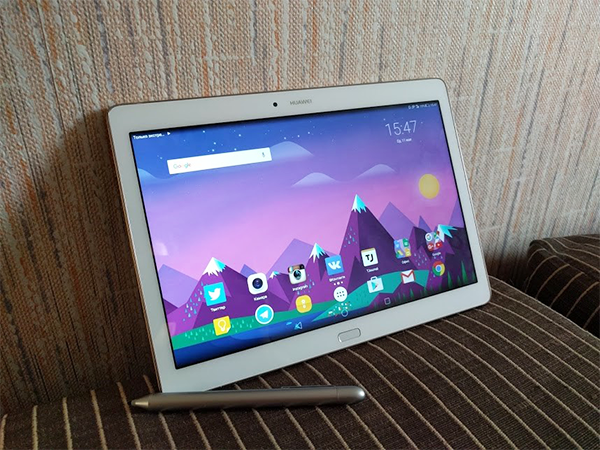
Introduction
The tablet market has long ago reached its maximum growth point and now their sales in the world are declining. Most of all, smartphones with large screens, which are now increasingly popular, are to blame for this. With such a gadget, there is no need for a small 7-8-inch tablet, which is why more and more buyers choose tablets with the maximum screen size for home (and not only) use. A similar situation was with laptops, after the decline in sales, only the strongest manufacturers remained on the market. In my opinion, it will be the same with tablets and just one of these companies is Huawei. Let's take a look at their flagship tablet, the M2 10
Specifications
– Screen 10.1 inch with a resolution of 1920×1200, IPS
– HiSilicon Kirin 930 processor (8 cores, up to 2GHz)
– 16/64 GB ROM, 2/3 GB RAM, there is a Micro SD slot
– Cameras 13 and 5 Mp
– Battery 6600 mA
– LTE support
– Metal body, fingerprint scanner, 4 speakers, stylus included
There are two versions of the tablet:
– Silver color, 2 GB RAM, 16 GB ROM, cost 35,990 rubles
– Gold, 3 GB RAM, 64 GB ROM, cost 39990r
As you can see, with a difference in price of only 4000r, it makes sense to take the premium version – 16GB of internal memory is not enough for a tablet, and 3GB of RAM gives a significant increase in performance.
In the review, it is the premium version of the gold color.
Design
Appearance and body materials are one of the strongest points of the M2 10. The tablet feels like a very expensive device in the hands, everything is assembled efficiently and perfectly.
I cannot call the gadget light, its closest competitors weigh 100 grams less (Galaxy Tab S2 and Sony Tablet Z4), but Huawei they put 4 speakers, a more powerful battery and all this in a completely metal case. therefore this weight is justified.

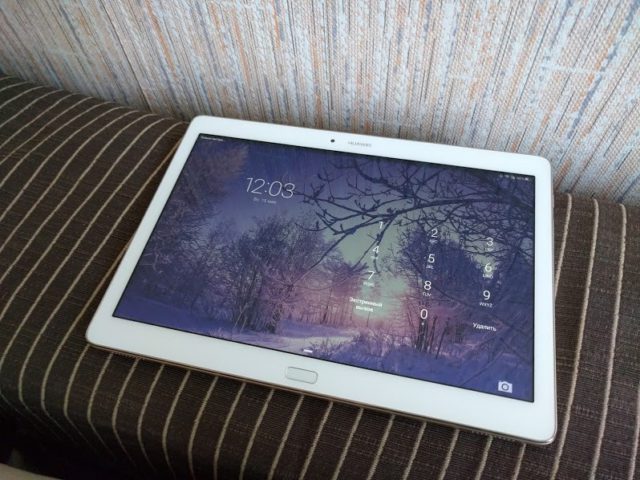
The shade of golden color was chosen well, the back panel looks great. All the acquaintances who saw the tablet said that it was very beautiful.

At the front is a screen with the thinnest possible bezels (if they were even thinner, the tablet would be inconvenient to hold). Below is a fingerprint sensor combined with a touch button, we will talk about them separately.

Above is a 5 MPi front camera with the company logo.
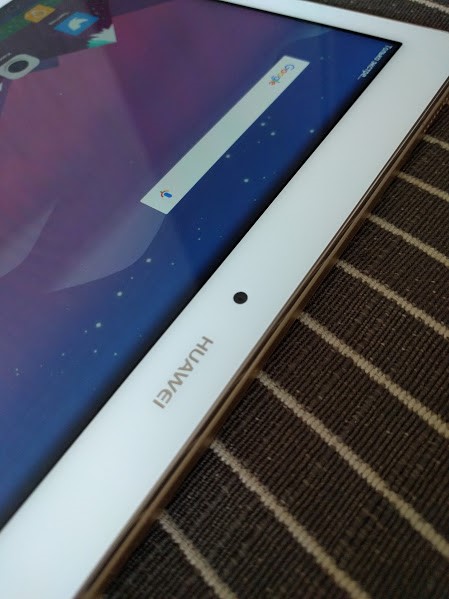
To protect the screen in case of falls, a small metal edging is additionally made, which protrudes a few millimeters above the glass.

The back is made of metal, there is only a small plastic insert, behind it are antennas for receiving and transmitting data from cellular networks, Wi-Fi and Bluetooth.
There is also a main camera with flash (13 MP), another company logo Huawei and Harman / Kardon.
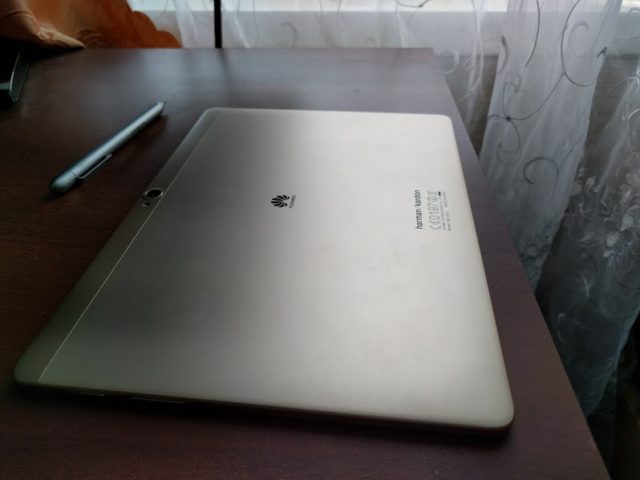
There are 4 speakers on the bottom and top of the case, the top also has a microphone and a 3.5 mm headphone jack. 

On the left side you can see slots for a SIM card, memory card and a connector for charging micro USB
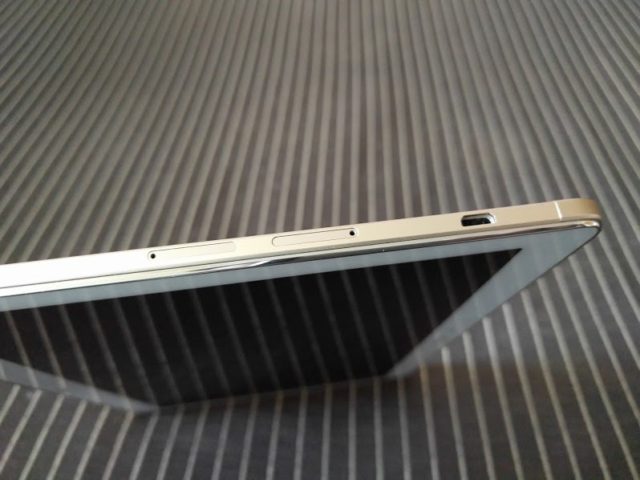
On the other side is the volume rocker and the power button
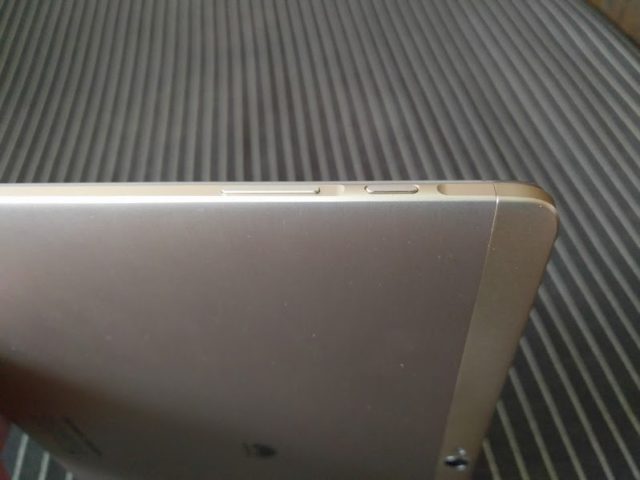
The design of the tablet is universal, it is suitable for both young people and adult buyers. I liked the M2 10 live much more than in the photos.
Screen
The most important part of a tablet is its screen. It is he who becomes a window into the world of content and the fewer distracting elements, the better. M2 10 is protected by tempered glass (the manufacturer does not indicate the brand of glass) with a high-quality oleophobic coating, due to which the finger glides pleasantly on the screen, leaving almost no prints.
Matrix type – IPS, without an air gap, thanks to which the color rendition of the screen is almost perfect. The viewing angles are also maximum. The screen resolution is 1920 × 1200 pixels, 224 ppi, which is more than enough for a 10-inch screen.

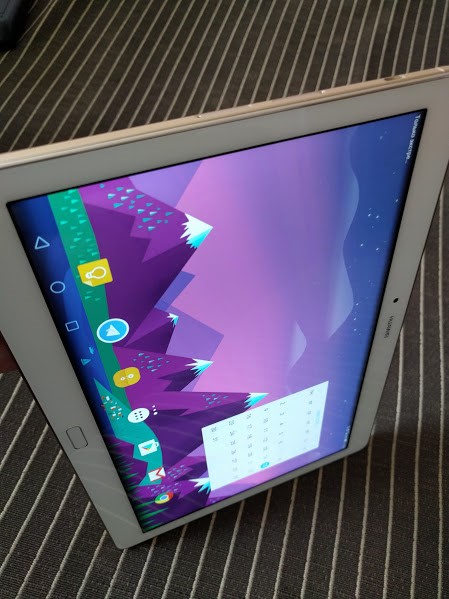
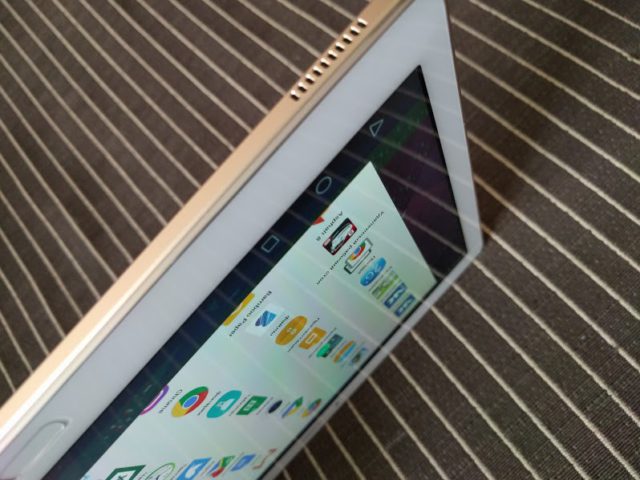
Compared to screens AMOLED in IPS, the color rendition is more natural and the white color is perfectly white. To be honest, I don't really like AMOLED, after a long reading on it my eyes get tired.
Only the Nexus 6P was at hand to show the difference in the transfer of white color between the matrices. The same will happen in Samsung tablets – instead of white, dirty green or pinkish is shown. Live this difference is more noticeable.
 The brightness of both devices is at maximum.
The brightness of both devices is at maximum.
The M2 10 uses the familiar 16: 9 aspect ratio, which allows you to watch movies with the greatest comfort. In the new Samsung tablets, the ratio is 4: 3 (as well as on Apple iPad), which makes it inconvenient to watch movies in this format, there will be large black bars above and below.
For a screen with an aspect ratio of 4: 3, it looks something like this:

On a tablet from Huawei, the movie takes up the entire screen area.
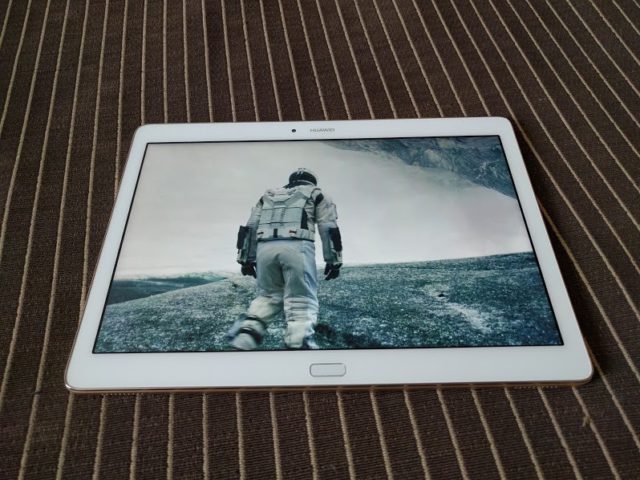
The only drawback of this 16: 9 format is that some applications are not optimized for it.
For example, the official Vkontakte app doesn't look very nice.

Or here's the news app 'Tjournal'

But these are problems of some applications, most software looks great on such a screen
Let's take Telegram and Gmail for example: 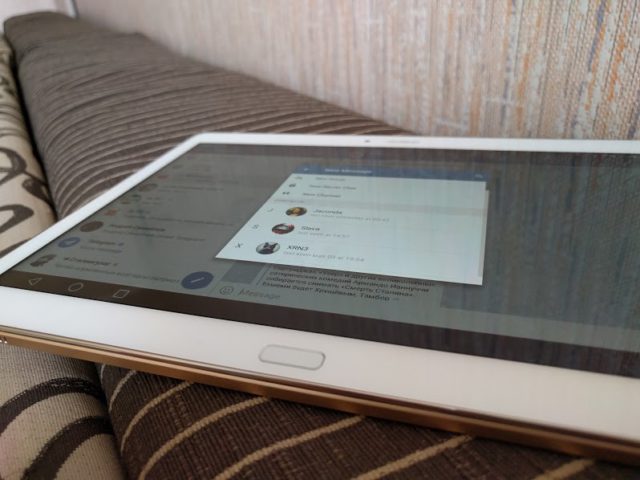
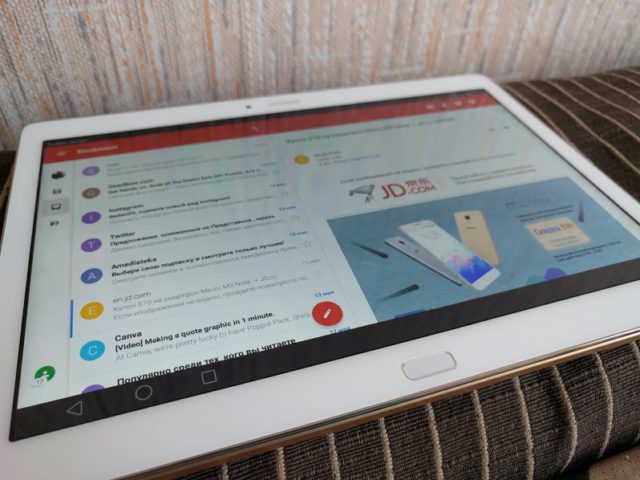
The large 10.1-inch screen makes it easy to use a remote desktop on your tablet.
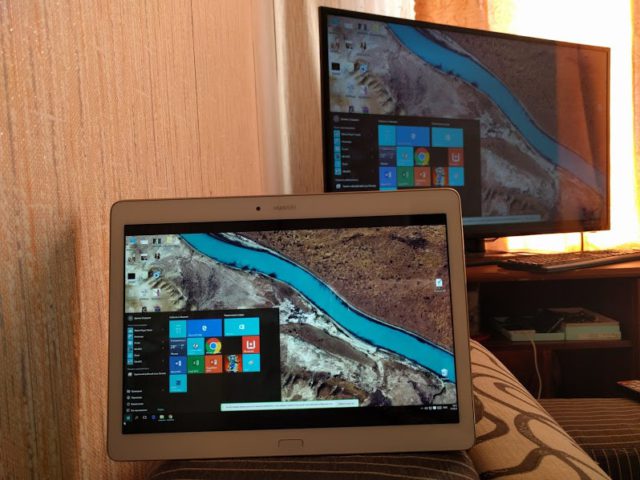
Recently Microsoft released their office suite for Android, with which you can easily edit text documents or spreadsheets on the go. It is quite convenient to do this on a large tablet screen (if you wish, you can even connect a mouse and keyboard).
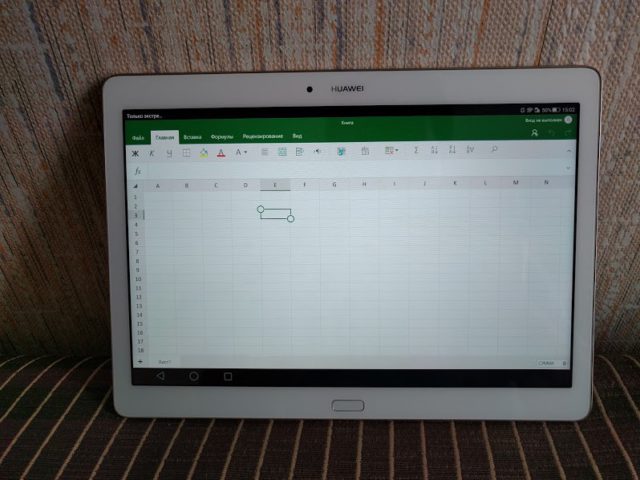

As a result, it is worth noting that the tablet screen matches the flagship device and is currently one of the best in quality.
Performance
In recent years, the company Huawei has established production of its own Kirin processors for mobile devices. The M2 10 is equipped with a 64-bit eight-core Kirin 930 chip. Like other eight-core processors, the Kirin 930 uses 4 weak and 4 powerful cores, which work in turn, depending on the load. The powerful cores are based on ARM Cortex-A53e cores.
The Cortex-A53e cores are designed by itself Huawei and differ significantly from the Cortex-A57 and Cortex-A53. Typical Cortex-A53 cores have a maximum clock speed of 1.2 GHz, which is not good enough for the high performance of flagship devices, so Huawei 'overclocked' the Cortex-A53 to 2 GHz, making them just as powerful like the Cortex-A57, but the cores remain more energy efficient.
According to Huawei, the Cortex-A57 cores are 56% more powerful than the Cortex-A53, but at the same time they consume 256% more power, which leads to increased heat generation and a decrease in device operating time. By using energy-efficient Cortex-A53e cores in the Kirin 930 processor, the company has managed to maintain a high performance figure while reducing power consumption.

Indeed, the M2 10 is very fast, I haven't seen any lags in several weeks of using the tablet.
After an hour of playing with a heavy 3D toy, the tablet also stays cold, its performance does not drop. I tried many different games, everything works perfectly and runs at maximum graphics settings.


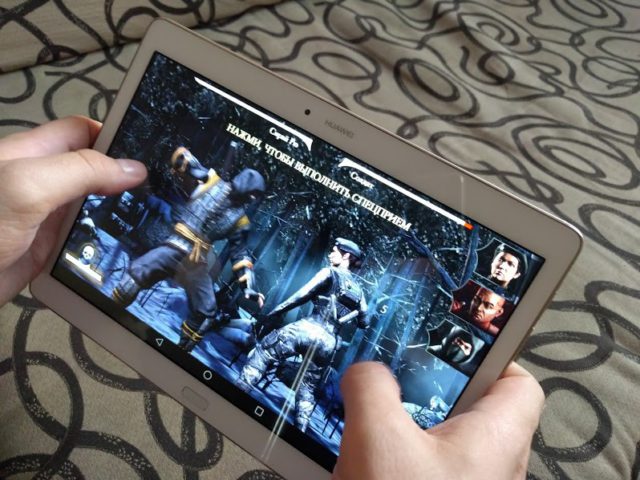

3 GB of RAM provides excellent multitasking performance – you can minimize more applications, dozens of tabs in the browser – they will not be loaded again when you open them again.
Another interesting feature of the tablet is the ability to run two applications on one screen at once. To do this, you need to hold your finger on the button for launching recent applications.


In synthetic tests, the tablet does not show impressive results relative to this year's flagship smartphones (about 50 thousand points in the Antutu benchmark). But do not let that confuse you, the numbers in the tests do not tell about the real performance of the device. It is also worth noting that the closest competitors of the Mediapad M2 10 (Galaxy Tab S2 and Xperia Tablet Z4) are gaining similar results in tests. The real capacity of the device will be more than enough for the next 3-4 years.
Software, stylus and fingerprint reader
Mediapad M2 10 runs Android 5.1.1 with EMUI 3.1 shell, which greatly changes the appearance of the operating system and brings many useful 'chips'
By default, everything looks like this:

All applications are located on the desktop (as in iOS), and their icons are rounded or changed altogether (as in the case of Instagram).
If you swipe down from the middle of the screen on the desktop, you will see a list of recently used applications and search among them, contacts, message and more.

A two-finger pinch on the desktop will open the settings in which you can change the wallpaper, animation of table paging and much more. And if, on the contrary, spread two fingers apart on the desktop, then a menu of hidden applications will open – you can hide unnecessary built-in software that cannot be removed:

Tablet multitasking menu:
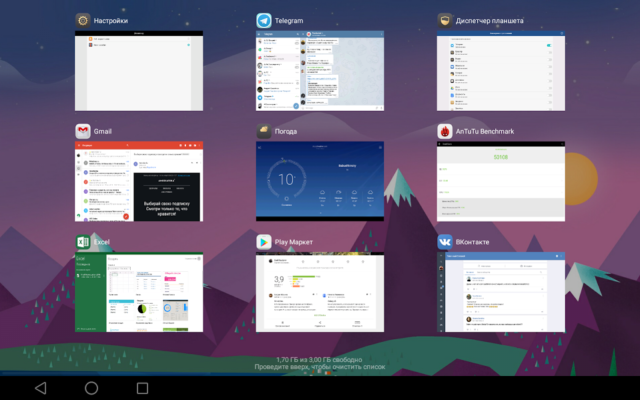
But in the settings there is a lot of useful things:

For example, you can customize notifications for each app:
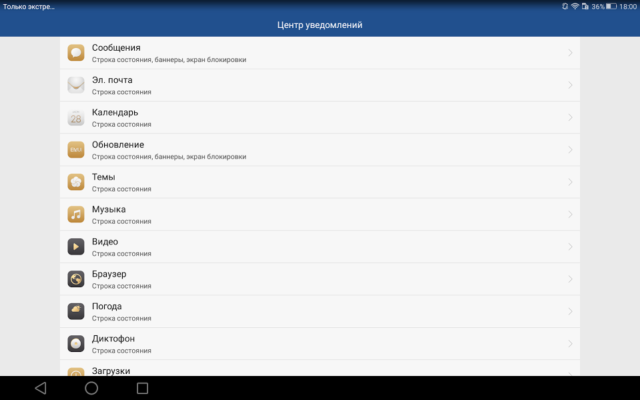
Or, prevent certain applications from running in the background after the tablet goes to sleep:

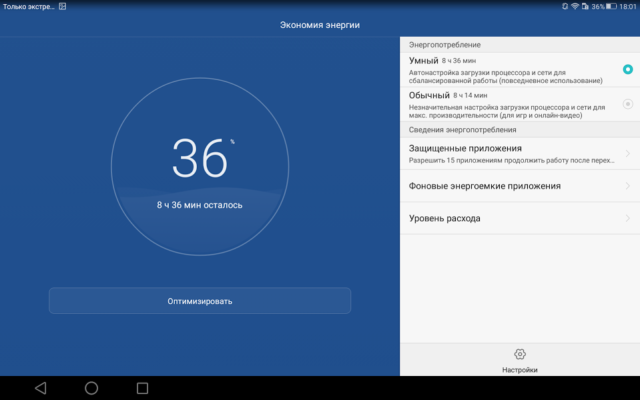
I really liked the memory cleaning function, it is a really useful program that removes cache and residual files from remote applications:
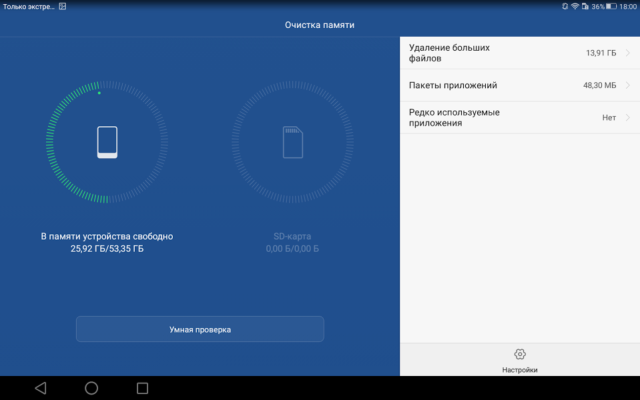
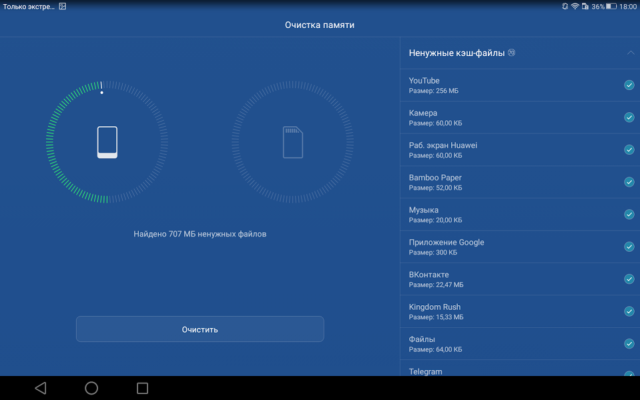
In the settings, you can change the bottom navigation bar. By the way, this is the first time I saw in a tablet the ability to move the buttons to one corner. It is convenient, there is no need to reach with your fingers in the middle of the screen.
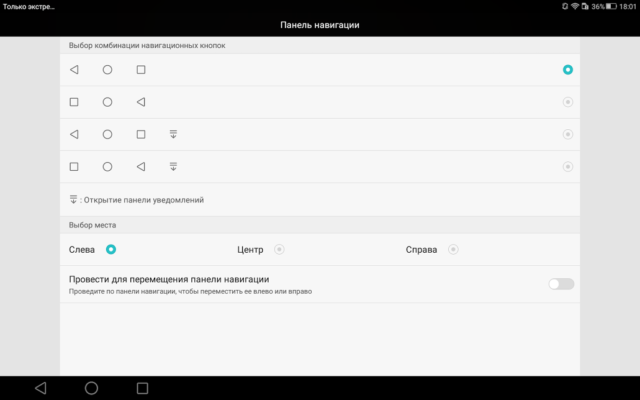
I love Android primarily because its look and feel can be customized using third-party applications. For example, I don't really like how the desktop looks on this tablet, so I just put in a third-party launcher.

I use the Nova Launcher application – in it you can adjust the size of icons, the number of applications that fit on the desktop, choose any theme for icons (I have standard icons from Android 6.0)
The usual list of applications will immediately appear, in which there is also a search, you can hide unnecessary software, create folders and much more.
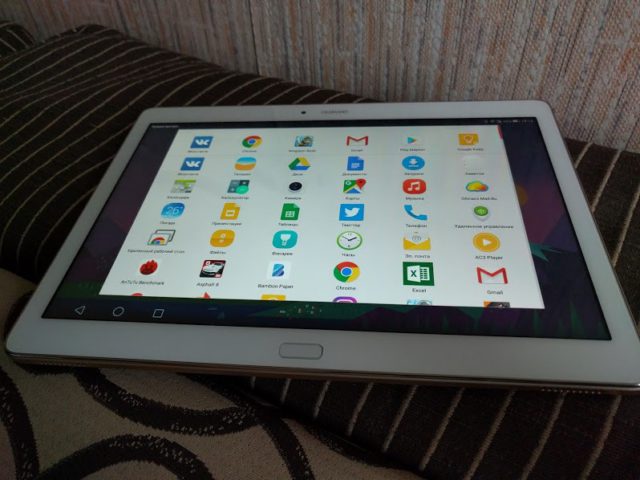
Now let's talk about the fingerprint scanner.
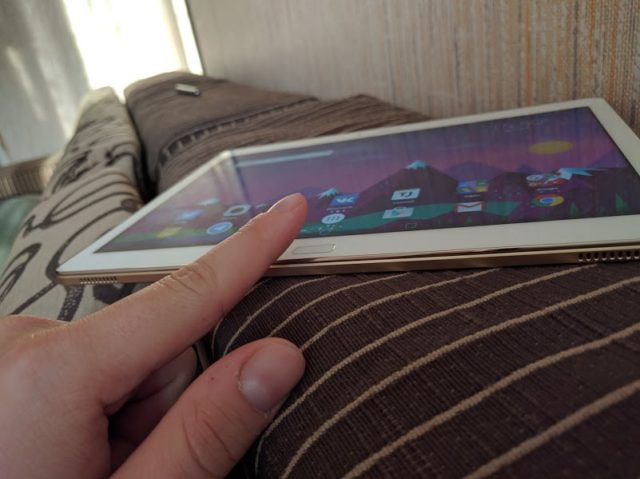
There is a separate item in the settings to configure the sensor, everything is very simple to configure.
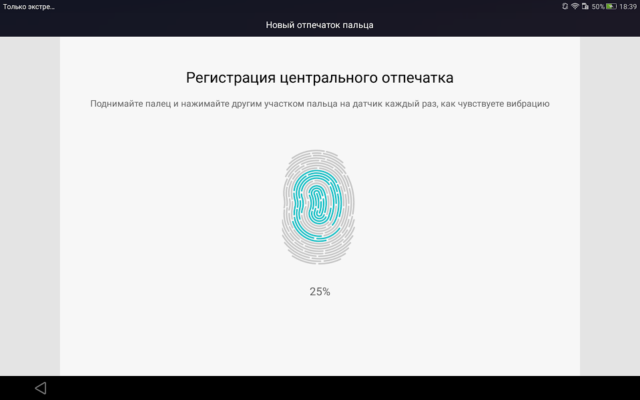
A total of 5 fingers can be added, and the same finger cannot be added a second time. Personally, I did this on smartphones Xiaomi to improve the accuracy of finger recognition. But as it turned out, in the tablet Huawei this is not necessary – the recognition accuracy is almost perfect, at the level of iPhone 6s and other flagship devices.
In order to unlock the tablet, you just need to bring your finger to the touch button and the device turns on instantly. I don't really like setting passwords, I have nothing to hide, but this way of unlocking is much faster than the classic lock screen. We usually press the power button and swipe across the screen to unlock the tablet. Here, to turn it on, you just need to put your finger on the button without even pressing it! Very comfortably.
You can also block any application with your fingerprint separately. There is a separate application for this – the tablet manager.
In it we select the required applications:
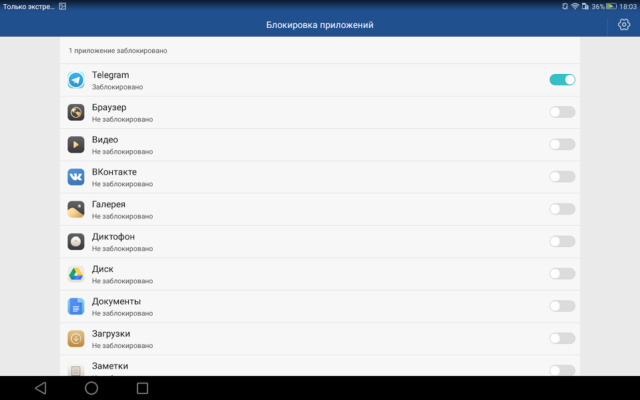
And when you try to log in, the application will ask for a password or a fingerprint:
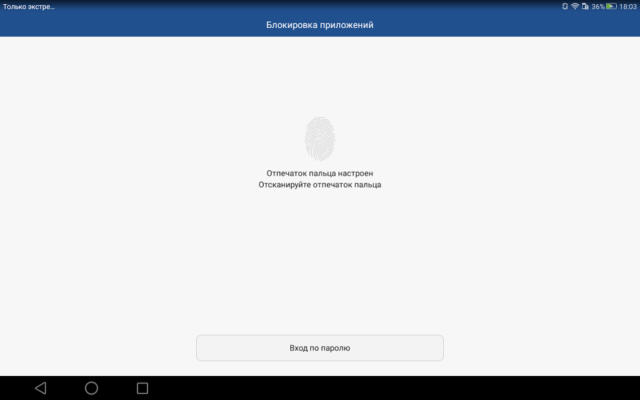
In addition, the touchpad can act as a navigation bar – swiping to the left replaces the back button, holding your finger on the button returns to the home screen, and swiping to the right launches the last running applications. It is a pity that the virtual navigation bar cannot be completely disabled in the settings, I would gladly use only this button. A similar implementation of the fingerprint scanner is made in new smartphones Meizu.
About the stylus

The stylus comes with a premium modification of the tablet (another reason to choose the golden version), runs on batteries and recognizes up to 2048 degrees of pressure.
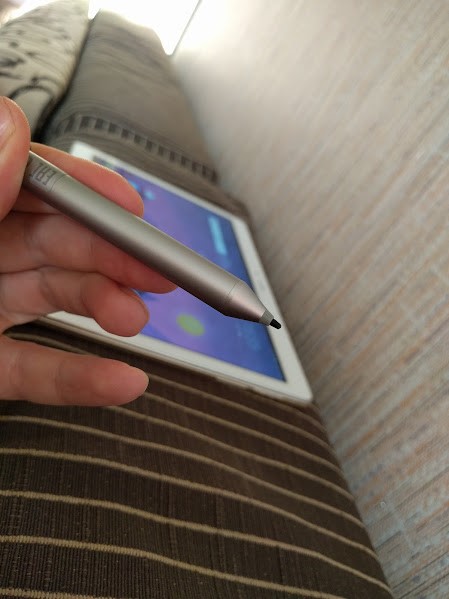
There are two buttons on the stylus body:
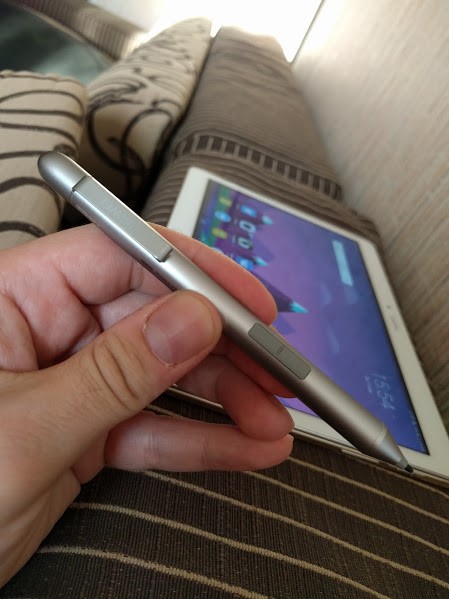
By holding one button, you can cut out any part of the screen and immediately draw something on it:
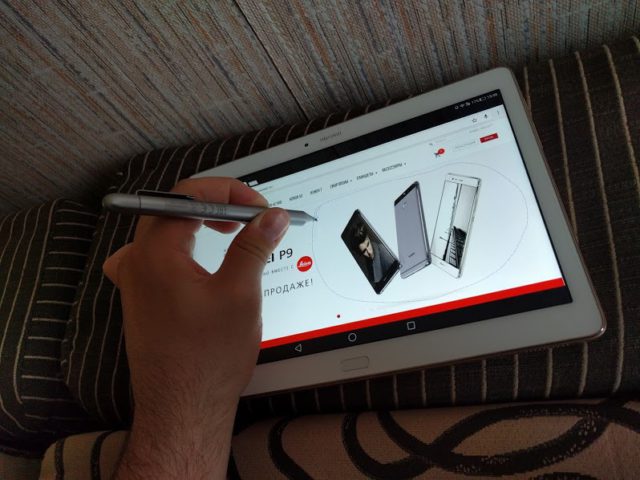

The second button works like an eraser.
The tablet comes with the built-in Bamboo Paper application, which supports all the capabilities of the stylus. When drawing, the application reacts only to the stylus, so you can comfortably put your hand on the tablet without fear of ruining the drawing.
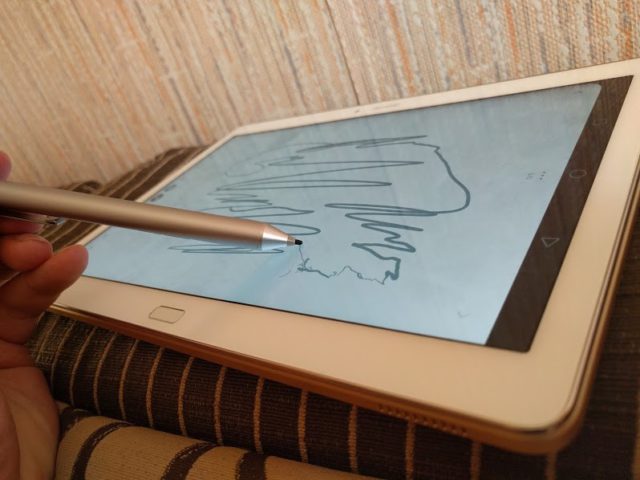
Unfortunately, I can't draw (at all), so I can't appreciate all the capabilities and accuracy of the stylus. Everything works great for my taste. It may not replace a graphics tablet for professionals, but for ordinary people who like to draw or take notes by hand, the stylus will be very convenient.
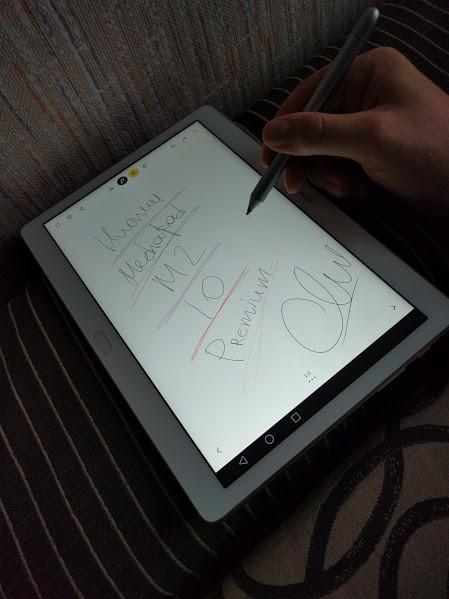
Multimedia
Huawei Mediapad M2 10 is a true multimedia monster! 4 speakers with a power of 4 watts are built into the case at once. The volume of the speakers is enough for the eyes, in a small room 50% volume is enough.
Together with Harman / Kardon, the Clari-Fi sound processing algorithm was developed, thanks to which, according to the company, the music regains the halftones lost due to compression, expressiveness and emotion. Thanks to all this, the sound from the speakers and headphones is very loud and clear. Watching movies and listening to music on your tablet is a pleasure.
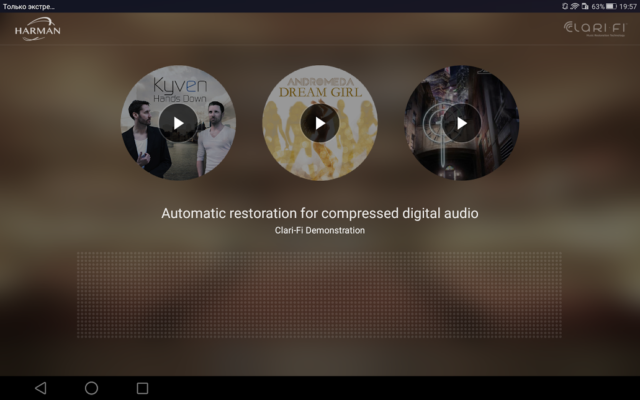
The tablet also has two cameras, 13 and 5MP.
The camera interface is quite simple, despite this there are a huge number of different settings available in smartphones Huawei.

Photos taken with the main camera are decent, even excellent in the daytime.



The front camera is suitable for undemanding users (you are unlikely to often take selfies on a tablet), for video calls, the quality is quite sufficient.

Battery
The tablet uses a 6600 mA battery.
The M2 10 showed decent battery life in all modes of use. At medium brightness, the tablet plays video for about 10 hours, a heavy game can be played for about 5 hours, and in reading mode, the tablet worked for 15 hours. We can say that the M2 10 performs about as long as its competitors in this price range.
I use a tablet for reading books and the Internet, in this mode it easily works for about a week.

I liked that the Mediapad barely discharges in the background, and in general, the tablet discharges smoothly, without sudden jumps. It is very difficult to drain the battery in a day – this is a big plus of the device.
conclusions
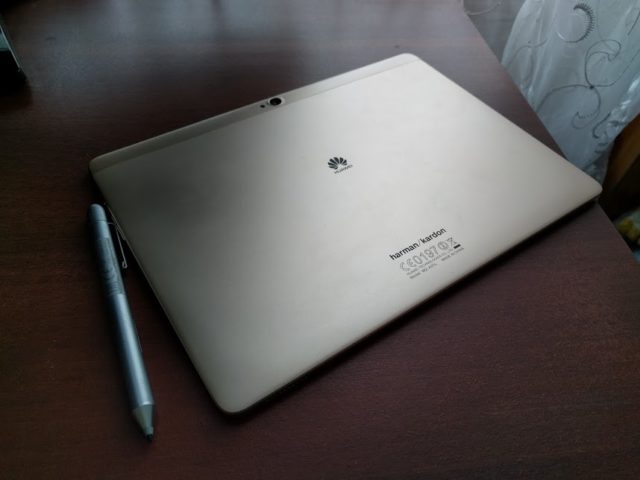
The company Huawei has long proved that it is not just catching up with the market leaders, but also ahead of them in many ways. With the M2 10 Premium you are getting the very best device for the money. Don't believe me? Let's compare the specs with the closest competitor like Samsung.
Samsung Galaxy Tab S2 9.7

– Inconvenient for watching movies aspect ratio 4: 3
– Less internal storage (32GB vs 64GB in Huawei)
– Smaller battery (5870 mA vs 6660 in Huawei)
– Plastic case
– Two speakers (M2 10 has 4 speakers)
– No stylus included
Despite the fact that Tab S2 is inferior in all respects, it costs 5000r more! The same situation is with the Sony tablet – it is worse in all respects and costs 45,000 rubles.
A similar version of the latter Apple iPad costs about 70 thousand, you can separately buy a stylus for 7000 rubles.
At first glance, the price of 40 thousand rubles scares a little, but if you try to look for a tablet similar in functions and characteristics, then you will not find anything better Huawei Mediapad M2 10 Premium.
